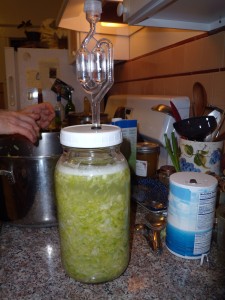We finally chopped up two batches of sauerkraut on New Year’s Eve. They’ve been sitting on the counter ever since, bubbling away and looking tasty.
In the end, we modified a recipe from a recently gifted cookbook, The Nourished Kitchen, by Jennifer McGruther. I’m always interested to read how long folks recommend letting fermented foods sit. McGruther suggests leaving the kraut for a minimum of six weeks before tasting and confides that she generally lets hers go for about three months.
When lacto-fermenting cauliflower pickles last year, I experienced the disappointment of letting a batch go too far for my taste. The resulting pickles were distinctly fermented and ‘gassy’ tasting with that special zing I associate with overripe or spoiled food.
I’m perplexed. I’ve read so many accounts of lacto-fermented foods bubbling away for weeks or months on end until they taste just right. These same recipes often recommend room temperatures of 65-70 degrees Fahrenheit. Our house is perpetually cold—usually in the 50s, so our pickles and kraut shouldn’t be fermenting extra quickly. The funky fermented taste that I can’t quite love seems to kick in by the end of the first week at the latest.
So what gives? Do I have terrible finicky taste in lacto-fermented foods? Is the funky zingy taste just a stage that I’m never patient enough to see through?
Blissfully unaware of the strict six-week timeline Kelly thought we were following for the sauerkraut, I opened up the airlock jars this week and took a taste. I should stop here and say we made two versions: a straight cabbage kraut a la the cookbook and a colorful kraut fashioned after our friend Tanya’s, but using the same cookbook’s base recipe–we love Tanya’s kraut, but she is out of communication on a foreign beach and unable to weigh in or provide her recipe.
In addition to cabbage, the colorful kraut features a few chopped cloves of garlic, grated ginger, and grated beet.
A week and a half into fermentation, and both krauts are distinctly funky to my palate. There’s no mold growing, and I have no reason to believe anything’s wrong other than my own impatience and/or poor taste.
Fingers crossed I didn’t introduce any bad bacteria by opening the jars. This time, we’ll give the kraut its time and hope that that does the trick.
Spicy SauerKraut Recipe
- 5 lbs. cabbage, finely chopped
- 2 tablespoons salt
- 2 cloves garlic, finely chopped
- 1 tablespoon beet, coarsely grated
- 1 teaspoon ginger, grated
Directions
- Quarter the cabbage, and then chop it very thin.
- Place cabbage in a large bowl and add salt. Let it sit for five minutes.
- Massage cabbage with salt for five additional minutes until the cabbage releases its juices (who knew a little salt would suck so much water out of a cabbage? This part was like a mad science experiment that caught us completely by surprise!)
- Add remaining ingredients (if desired) and mix thoroughly.
- Fill jar or crock with cabbage mixture, packing it down firmly as you go.
- Pour any remaining juices from the bowl over the packed cabbage and place a small jar or other weight on top of the kraut. This will help keep the cabbage from floating to the surface of the liquid. close the lid
- Let sit for six weeks before tasting (or, if you’re like me, taste it a week in and see what’s really going on in there!)
- Enjoy!










5 Responses to Experiments in Sauerkraut